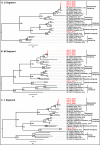Evidence of circulation of Orthobunyaviruses in diverse mosquito species in Kwale County, Kenya
- PMID: 34641884
- PMCID: PMC8507213
- DOI: 10.1186/s12985-021-01670-5
Evidence of circulation of Orthobunyaviruses in diverse mosquito species in Kwale County, Kenya
Abstract
Background: Arbovirus surveillance and recurrence of outbreaks in Kenya continues to reveal the re-emergence of viruses of public health importance. This calls for sustained efforts in early detection and characterization of these agents to avert future potential outbreaks.
Methods: A larval survey was carried out in three different sites in Kwale County, Vanga, Jego and Lunga Lunga. All containers in every accessible household and compound were sampled for immature mosquitoes. In addition, adult mosquitoes were also sampled using CO2-baited CDC light traps and BG-Sentinel traps in the three sites and also in Tsuini. The mosquitoes were knocked down using trimethylamine and stored in a liquid nitrogen shipper for transportation to the laboratory where they were identified to species, pooled and homogenized ready for testing.
Results: A total of 366 houses and 1730 containers were inspected. The House Index (HI), Container Index (CI) and Breateau Index (BI) for Vanga Island were (3%: 0.66: 3.66) respectively. In Jego, a rural site, the HI, CI and BI were (2.4%: 0.48: 2.4) respectively. In Lunga Lunga, a site in an urban area, the HI, CI and BI were (22.03%: 3.97: 29.7) respectively. The indices suggest that this region is at risk of arbovirus transmission given they were above the WHO threshold (CI > 1, HI > 1% and BI > 5). The most productive containers were the concrete tanks (44.4%), plastic tank (22.2%), claypot (13.3%), plastic drums (8.9%), plastic basins (4%), jerricans (1.2%) and buckets (0.3%). Over 20,200 adult mosquitoes were collected using CDC light traps, and over 9,200 using BG- sentinel traps. These mosquitoes were screened for viruses by inoculating in Vero cells. Eleven Orthobunyavirus isolates were obtained from pools of Ae. pembaensis (4), Ae. tricholabis (1), Cx. quinquefasciatus (3), Culex spp. (1) and Cx. zombaensis (2). Five of the Orthobunyaviruses were sequenced and four of these were determined to be Bunyamwera viruses while one isolate was found to be Nyando virus. One isolate remained unidentified.
Conclusions: These results indicate circulation of Orthobunyaviruses known to cause diverse grades of febrile illness with rash in humans in this region and highlights the need for continued monitoring and surveillance to avert outbreaks.
Keywords: Bunyamwera virus; Mosquitoes; Nyando virus; Orthobunyaviruses.
© 2021. The Author(s).
Conflict of interest statement
The authors declare that they have no competing interests.
Figures




References
-
- Ajamma YU, Onchuru TO, Ouso DO, Omondi D, Masiga DK, Villinger J. Vertical transmission of naturally occurring Bunyamwera and insect-specific flavivirus infections in mosquitoes from islands and mainland shores of Lakes Victoria and Baringo in Kenya. PLoS Neglect Trop Diseases. 2018;12:e0006949. doi: 10.1371/journal.pntd.0006949. - DOI - PMC - PubMed
-
- Blitvich BJ, Beaty BJ, Blair CD, Brault AC, Dobler G, Drebot MA, Haddow AD, Kramer LD, LaBeaud AD, Monath TP, Mossel EC, Plante K, Powers AM, Tesh RB, Turell MJ, Vasilakis N, Weaver SC. Bunyavirus Taxonomy: Limitations and Misconceptions Associated with the Current ICTV Criteria Used for Species Demarcation. Am J Trop Med Hyg. 2018;99:11–16. doi: 10.4269/ajtmh.18-0038. - DOI - PMC - PubMed
-
- Clark JJ, Gilray J, Orton RJ, Baird M, Wilkie G, Filipe AS, Johnson N, McInnes CJ, Kohl A, Biek R. Population genomics of louping ill virus provide new insights into the evolution of tick-borne flaviviruses. PLoS Negl Trop Dis. 2020;14:e0008133. doi: 10.1371/journal.pntd.0008133. - DOI - PMC - PubMed
Publication types
MeSH terms
LinkOut - more resources
Full Text Sources
Miscellaneous

